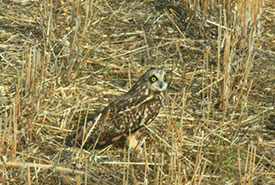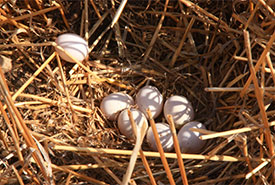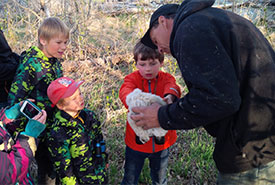Conservation on a working landscape

The ground nesting, short-eared owl spotted from the cab of Bruce's tractor. Bruce stopped his tractor, found the nest, and saved the eggs because he could identify the bird and knew its ecology. (Photo by Bruce Boldt)
I want to share an interesting conversation I had with my friend Bruce a couple of weeks ago. We had both recently attended a meeting by the South Saskatchewan Water Stewards about environmental farm plans, decommissioning wells and the threat of zebra mussels. I had trouble imagining what Bruce, a farmer of annual crops, would get out of some of these talks. Did he have a well he needed to decommission? Any zebra mussels attached to his combine? It has been pretty wet around here the last couple of years, but I didn’t think that was it either.
Bruce explained that as farmer and a member of a local nature society, he felt it was important to understand how those from more urban settings experience and enjoy more rural, nature-filled lands. We discussed birding and wildlife-viewing opportunities on his farm, and how he personally cares for wildlife and sees some urban folk wanting to view wildlife species, more fully understand nature and how land conservation helps sustain these wildlife. Bruce and I talked about how his family farm was larger than most farms in the area (5,000 acres/2,000 hectares of crop land in the Saskatoon area), which gave him the opportunity to conserve part of his property — something that a smaller farmer might not be able to afford to do because they might need to use all of their land to grow crops.
Bruce has many examples of how he helps conserve nature. For instance, just last season while seeding a field, on two occasions a short-eared owl had flown up in front of his tractor.

Bruce found and avoided this short-eared owl nest on the field he was seeding. (Photo by Bruce Boldt)
Within about five minutes, Bruce found the nest and drove his equipment around it. The 15 eggs he didn’t crush remained because he knew what the species looked like and how it nested, and he had decided to take the time to make a small difference by stopping, looking carefully, and driving around the nest.
Bruce also told me about his own back 40 acres (16 hectares), which used to be the pasture for the milk cows but didn’t serve any practical purpose now. Some of his neighbours thought it looked weedy and out of place next to their tidy fields of wheat and canola. However, Bruce likes having a place to walk around and watch birds and has planted many trees on the land. He doesn’t feel the need to straighten out every field or level every bush on his farm. Those places and the plants and animals in them have a value to him, in addition to the fields he uses for agricultural purposes.

Bruce Boldt teaching kids from the Saskatoon Nature Society how to handle a recently banded baby great horned owl (not a short-eared) on his farm's property this spring. (Photo by Matthew Braun/NCC staff)
Many farmers have their first encounters with nature from the seat of a tractor or by walking a bushy fence-line, perhaps exploring an old rock pile. Farmers have years of experience observing their fields, bushes, sloughs and wind breaks through the seasons.
Farmers like Bruce provide great insight for conservation organizations like the Nature Conservancy of Canada; they help us (NCC) understand the challenges of farming and how land managers are helping conserve nature. In a place where so much of the land we want to work with is held privately by people who farm, ranch or even extract gravel, collaboration with managers like my friend — someone interested in wildlife and taking extra steps to conserve natural lands and wildlife — is vital. In turn, NCC can tailor its land stewardship to complement the needs of land managers.
Bruce had some additional thoughts after reading my draft of this post:
"With some farmers, conservation of nature is only one of many considerations with their farming operation. Others take a great deal of pride in being a good steward of the land. I believe there is great opportunity to further how we farmers can help nature along. As in the case with the short-eared owls, sometimes it is a matter of us farmers being a little more exposed to some 'nature education'!"
These are the thoughts I had, not quite from the cab of my tractor, but at least with the memory (and hearing loss) of its diesel engine in mind.


